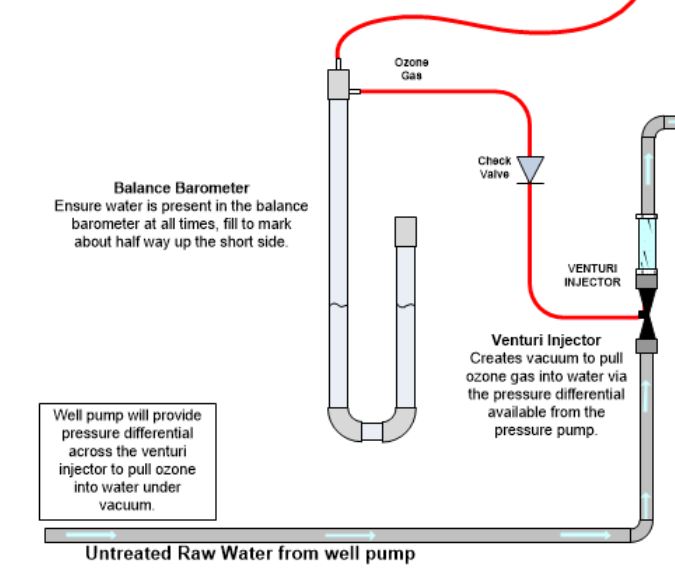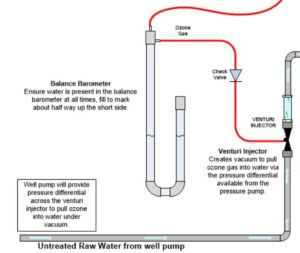A balance barometer is a very simple device that provides fool-proof protection of ozone generating equipment in a venturi injection system. As someone new to the ozone industry learning how to harness the power of ozone, I was intrigued by the balance barometer I was asked to construct for one of our systems. How does it work? Why are they useful? Is there anything particular about the dimensions that make it work properly?
A balance barometer is used to keep water from backing up into the output side of an ozone generator. Corona discharge ozone generators will reliably generate ozone if, and only if, they stay very dry. Any moisture coming into the ozone generator will shorten its life. In a system where a venturi is used to inject and dissolve ozone in water, a catastrophic flood of water into the ozone generator is always only seconds away. Critical to the success of any such system is that point between the ozone generator and injecting the ozone into the water stream.
Under normal operating conditions, the venturi through which water is forced will create suction and prevent any water from flowing back to the ozone generator. This water will immediately flow to the generator if water flow is reduced or stops in the venturi. A simple check valve is built into Mazzei venturis to prevent this backflow. An additional series of stainless steel and Kynar check valves will stop or slow this water most of the time. But even “slowing the water” or “most of the time” is a risk that can be eliminated with a simple balance barometer.
A balance barometer is a U shaped tube with one side about twice as high as the other. The top of the high side is capped off, and two holes are drilled into the cap: one straight down from the top, and one in the side at the bottom edge of the cap for ozone tube fittings. One inch clear PVC works well for visual monitoring, and the diameter allows bubbles and water to pass by one another without hindering its performance.
So let’s hook it up to see how it works. The very top fitting goes to the ozone generator, and the side fitting just below the top fitting goes to the venturi suction port in our system. If sufficient water flows through the venturi, it will begin to draw air through the check valves, ozone generator, and balance barometer. If we put some water in the balance barometer, it will block off air flow through it and force all the flow to pull through the ozone generator. This would be the normal operation.
Now if the particular water system has some water pressure when water isn’t flowing through the venturi, as in a well water system, water will be forced back out the injection port. The check valve should prevent water back flow, but if ozone has deteriorated the seal or a tiny speck of something prevents a tight seal, water will begin to flow past it and toward the ozone generator. When it reaches the balance barometer, it will simply add water to it until the short end overflows. Once water flow is restored to the venturi, the suction will return. Any water in the line or extra water in the barometer will be sucked into the venturi and normal operation resumes.
The balance barometer works well with ozone generators that operate under very low pressure or a slight vacuum. Only 1 psi of pressure or vacuum will balance with 27 inches of water making the minimum size short side of the tube for such a system 27 inches. Systems that simply use the venturi to pull air through the ozone generator work well with a balance barometer. If a balance barometer is not practical for a particular application, our stainless steel backflow preventer will provide the same type of protection using a built-in float.



Hi John,
Thank you so much for this informative post. I have not been able to find much information on balance barometers and found this so helpful. I do have a question for you regarding my balance barometer– after my ozone generator shuts off, about 1/4 cup of water flows back into the barometer through the tubing attached to the Mazzei injector, making the barometer overflow. Interestingly, if I take the tubing off the injector no water flows out at all and it closes up right away. I have checked for the debris in the injector and it is fine. I have never had this problem before. Any ideas on why this might be happening?
Thanks!
Marshall
My apologies for bugging you again, but I’m really at a loss.
Thanks so much,
Marshall Raskind
Hi Marashall,
From my experience with check valves, I have learned that they frequently fail to do the job perfectly, especially when they are subjected to ozone. As simple as they are, they offer plenty of puzzling challenges. In your case, it seems to me that the only difference between having the tube connected and having it off is the presence of ozone and a slight difference in pressure. If your check valve has viton or plastic parts, I am inclined to think that the ozone is making it slightly sticky and slows its operation. If we rely solely on check valves, we use three different types relying on their combined strengths to stop the water. In our service plan for customers with continuously operation injectors, we replace all three on a monthly basis. A motorized ball valve does not provide immediate checking, but they have proven to be more reliable. In your case, it is much better to have a wet mess from your balance barometer than having that water in your ozone generator. It might be time for you to replace your check valve. Thanks for the question. I welcome any other suggestions.
John, thank you so much for your prompt and thoughtful reply– very helpful! I think it’s time to order some check valves from you.
Marshall
What fittings do you recommend using in the balance barometer?
Thanks,
Dennis Cossins
We use 1″ PVC or larger. The tubing connecting to the balance barometer for ozone gas line is 1/4″ ID, we use 1/4″ barbed fittings for this,